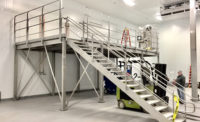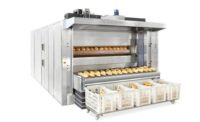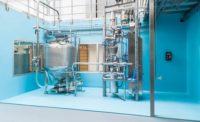The internet of things (IoT) refers to interconnected devices embedded in everyday objects that provide the ability for people to remotely connect with those devices—or for those devices to remotely connect with one another.
Our digital transformation
Bühler Group, Uzwil, Switzerland, sees four key principles involved in making this digital transformation, says Dorian Kusznir, engineering manager. Companies need to understand their customers’ pain points and what they want, properly structure the data garnered to make sure it’s useful, provide that actionable data back to the customer, and then touch base with your customer to make sure they’re engaged with the solutions you’ve provided.
The company has developed the Bühler Insights connectivity platform for snack and bakery customers as well as those in other industries. It’s a standard solution that can be customized to each industry and different types of machines, Kusznir says. Bühler has developed an e-learning module to help customers understand the platform and an online parts ordering interface for greater efficiency.
In snack and bakery production, Bühler’s platform can gather metrics to help to determine, for example, which recipes tend to create the most headaches and why, or which shift in the factory performs better than another and why. It can also help operations staff best to coordinate production schedules to meet goals. This comes in handy when production goals are not met. “We can drill down through advanced analytics and see why you didn’t meet your goals,” says Kusznir.
The Bühler Insights platform notifies users in real-time when metrics are not what they should be. “You’re trying to heat a product at a certain time, for a certain period of time,” Kusznir says. Rather than finding out later that a batch of nuts has questionable attributes, the customer finds out right away. And these innovations will continue to push forward and become optimized over time, he says.
Forward-thinking vision
Forpak, Burnsville, MN, offers solutions for identifying and sorting out defective products on a snack or bakery line. “If a cracker is broken, or any type of product is a partial, we want to reject that from the line,” says Dave Brownson, engineering manager. “With more and more people coming off the lines, and more and more automation coming in, it requires that type of machine vision.”
The IoT offerings from Forpak count the pieces per minute in every lane of a machine, to know whether the product is flowing more heavily in one lane vs. another, as well as detecting whether the product stack height shows the correct number of pieces or not, rejecting any that aren’t right before they go further downstream into packaging, Brownson says. The system also sounds alerts if there’s a lane jam, or if product isn’t moving quickly enough.
“The machine will capture all of this data, and then it’s going to the cloud via a connected Ethernet, Wi-Fi or cellular connections,” says Brownson. “You’re getting ‘X’ amount of pieces or stacks. Alerts can pop up if this happens at this amount of frequency—you need to think about replacing the cylinders, or go out and make an adjustment if the line jams. It’s not only over a single day, but you can track for weeks, or years.” This helps snack producers and bakers quickly determine their inefficiencies through data analysis.
Plant managers and owners are not on the floor every day, and the IoT can tell them whether ingredients are covering the top of a bun properly, whether a line is up or down, and what’s causing the down time, Brownson says. “If they’re getting the information they need, it makes the job go a lot easier.”
Sightline Process Control, an operating company of KPM Analytics, Milford, MA, generates real-time, three-dimensional color images of products as they’re created so that snack and bakery plants can make efficient decisions about production and quantity, says John Lawrence, CEO.
“It’s about measuring volume, toppings coverage, slopes,” says Lawrence. “The concept of 100 percent inspection is a very powerful tool—not only to improve quality, but also production and changeover time. Through the magic of the internet, you can see those production metrics anywhere in the world.”
The Measura Analytics dashboard from Sightline also allows the user to generate historical reports, and the technology can be installed across all production facilities to compare data, Lawrence says. “You can inspect who makes the best product X, and who makes the best product Y, and why it’s changed over time at this bakery and not this bakery,” he says. “We have a customer who has bought 37 systems for all their production lines. We’re working with them to create the ultimate dashboard, where they can see all of their production in real time.”
Process Sensors, Milford, MA, another KPM operating company, makes IoT moisture gauges called IP 69 that have numerous applications across snack and bakery, says Maurice Janssen, vice president of global sales and mobile marketing. “You have to make sure your flour has a certain moisture percentage,” he says. “When we think of potato chips, moisture is a killer to shelf life, and also during production. Measuring that in process is something that is very important for these kinds of companies.”
Process Sensors installs moisture gauges that connect to the customer’s network so they can better control their production lines and find the best balance between moisture and heat during baking, Janssen says. “It’s easy to get that information into an internet environment, whether it’s on their laptop computer in the office, or remotely on a dashboard,” he says. “It can be controlled remotely, but generally they want it to go automatically, which is faster.”
EyePro Systems USA, Chicago manufactures inspection systems for snack production and bakeries that can handle two- and three-dimensional imagery. EyePro’s Vision Technology can measure product diameter, examine the surfaces of products to make sure that a bun has the right amount of seeds, for example, and detect defects such as incorrect size, or broken pieces, says Erica Vannini, sales and customer service.
“We have products that monitor different dimensions, the height of a product, or the color of a product,” says Vannini. “We use the system to gather data and present it to the operators in different ways.”
Technology on the move
Hyster Co., Portland, OR, offers the Hyster Tracker wireless asset management system for lift trucks, which allows operations to view and analyze key data from mobile equipment in one dashboard, says Steven LaFevers, vice president, emerging technologies. The system communicates via cellular or Wi-Fi to provide automated maintenance alerts and clear, interactive reports about equipment use, impact and efficiency, as well as operator performance.
“Snack and bakery operations managing lift trucks can start moving beyond reactive decisions to preventative and even predictive measures,” says LaFevers. “For example, instead of using data simply for tracking the timeframe in which certain components will need maintenance, operations can instead monitor components via sensors or other telematics systems and set up automated alerts in the event that an anomaly, like a certain amount of wear, or a low battery, is detected.”
Yale Materials Handling Corp., Greenville, NC, uses a Yale Vision IoT system for wireless asset management of lift trucks. The telemetry solution transfers data to the cloud, where desktop or mobile apps can access it, providing operations with the freedom to select the best option for their needs, says Kevin Paramore, emerging technology commercialization manager.
“Yale Vision provides data-driven insights for optimizing fleet maintenance, structure and operator performance, including lift truck utilization, safety checklist compliance, impacts and more,” says Paramore. “For example, take an operation that relies on a mission-critical fleet of lift trucks to move inventory from storage to shipping docks. Introducing a telemetry system can add an extra layer of business intelligence to more cost-effectively ensure fleet uptime.” That can include automated alerts and fault code tracking to trigger preventive service, he adds.
“One of the most-important benefits of the IoT and connected devices is visibility,” says Paramore. “In addition to optimizing equipment, processes and labor, its use can extend beyond the four walls, creating intersectional opportunities to increase labor productivity throughout the supply chain. Thanks to big data, linear supply chains are evolving into complex, dynamic and connected networks, based on the exchange of information that drives increasingly efficient, more transparent manufacturing, distribution, and direct-to-store delivery.” And that can quickly result in gaining a competitive edge in the market.




